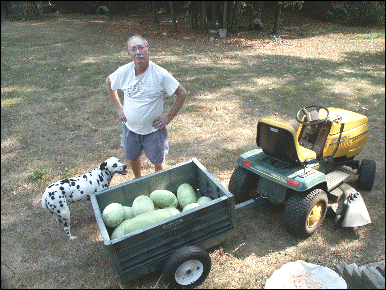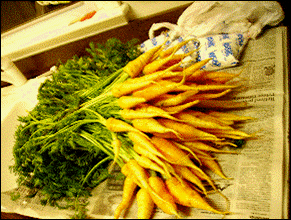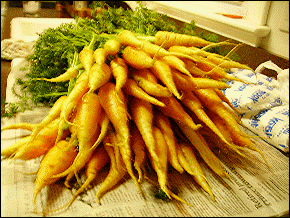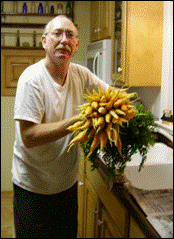|
Food for eating, freezing and Canning |
|
|||||||||
|
|
The Garden in the spring is
always lovely.† Here, in the back, you
can see crops of sugar snap peas on the left and right with multiplier onions
and garlic to the center.† Green beans are
doing well in the front right. |
|
||||||||
|
|
|
|
|
|||||||
|
|
|
|
|
|
||||||
|
Close up of how multiplier
onions grow. |
Lettuce
grows nicely by the raised bed of onions.†
The raised bed keeps the lettuce roots cool. |
Strawberries
grew in the lower terraced gardens and produced many sweet
berries for jams, margaritas and all around good eating. |
Close up
of sugar snap peas before blossoming.
|
|
||||||
|
|
This
particular year we harvested approximately 6,500 multiplier onions! All our
friends and neighbors thought we were very generous. |
|
Bob
designed these racks made of wood and chicken wire to hold the onions while
they dried.† The racks allowed for air circulation.† Cured and kept in a cool dry place the
onions will keep until the following spring. |
|
||||||
|
|
Donít even
try to pull up the garlic and onions without a fork. |
|
|
|
||||||
|
Stay tuned for an update with some more
Fore Technology for drying and storing onions and garlic till the next
season.† We have been successful
keeping them from May harvest until the almost the next May harvest. Detailed instructions from Bob on
curing garlic and onions to be added. |
|
|||||||||
|
|
|
|
|
|
||||||
|
|
|
|
|
|
||||||
|
Beets are a cooler weather
crop, not for summers.† To start this planting Bob
covered them with garden cloth that allows filtered sun, air and water to
penetrate while shading the crop so the beets wonít get woody. |
This is a
small planting of lima beans in the front here.† Horseradish
is growing behind that.† It is a root
crop that is one of the few plants we know with 2 different leaves. |
Here is a
closeup of some limas on the vines.†
This is a crop that once planted, does not like to be disturbed
much.† We try to leave them alone with
gentle weeding. |
This is a
heat tolerant spinach called Mallobar.†
It is a vine that grows up and trellises nicely while bushing out at
the bottom too.† It has a slightly
stronger flavor than regular spinach but is an easy grower, prolific, and
will reseed itself for next year. |
|
||||||
|
|
|
|
|
|
||||||
|
|
|
|
|
|
||||||
|
|
|
|||||||||
|
Living literally at the top of the hill presents
some challenges when it comes to gardening.†
To overcome of them, we created terraces that broke the grade of the
hill into steps.† Strawberries
flourished in years past but in 2006 we are trying watermelons and
cantaloupes there as it seems to be a wet area they would like and they would
have the room to spread out. |
|
|||||||||
|
|
|
|
||||||||
|
See our baby cantalope?† This is our first year to plant a melon
patch and the vines are taking over the lower terraces where they were
planted. |
The vines are literally jumping over the old
railroad ties, down into the grass and up into the garden.† |
|
||||||||
|
Stay tuned for updates on our melon patch!† The watermelons are supposed to get to be
35 pounds!† |
|
|||||||||
|
|
Here is a
picking from the 06 melon patch.† Thank
heavens for the garden cart! |
|
||||||||
|
|
This apple tree was planted in 1987.† We havenít had too many harvests from it
since it requires beating the squirrel and deer to the crop.† But, when we do harvest they make good
dried apples (try adding a little cinnamon and sugar), fried apples and pies. We have a cherry tree too.† Bob has been fighting the squirrels and the
birds for those.† The
are great cobbler and pie cherries, a little tart Ė not bad - but
sugar helps with that. |
|
||||||||
|
Here is
the happy farmer. |
|
|||||||||
|
|
|
|
|
|
||||||























